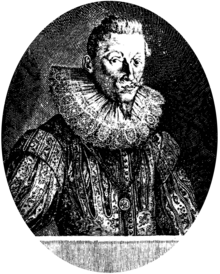Cantiones sacrae (Schütz)
| Cantiones sacrae | |
|---|---|
| by Heinrich Schütz | |

The composer of the collection in 1627
|
|
| Catalogue | Op. 4, SWV 53 to 93 |
| Genre | Sacred vocal music |
| Language | Latin |
| Based on | Precationes by Andreas Musculus |
| Dedication | Hans Ulrich von Eggenberg |
| Published | 1625 in Freiberg |
| Scoring |
|
Cantiones sacrae (Vocal sacred music, literally: Sacred chants), Op. 4, is a collection of forty different pieces of vocal sacred music on Latin texts, composed by Heinrich Schütz and first published in 1625. The pieces have individual numbers 53 to 93 in the Schütz-Werke-Verzeichnis (SWV), the catalogue of his works. The general title Cantiones sacrae was common at the time and was used by many composers, including Palestrina, Byrd and Tallis (1589 and 1591) and Hans Leo Hassler (1591).
Schütz composed the motets and madrigals, based on texts from a 1553 prayerbook Precationes by Andreas Musculus, for four voices (SATB) and basso continuo. Some of the settings form groups of up to five pieces, including the expressive Passion motets, Quid commisisti, SWV 56 to 60. Cantate Domino, SWV 81, is a joyful setting of Psalm 149. The Protestant composer dedicated his work to the Catholic politician Hans Ulrich von Eggenberg. He published it as his Opus quartem. The counterpoint of the Cantiones has been regarded as unmatched in the sacred vocal works of the 17th century.
Schütz composed the pieces during the first years of the Thirty Years' War, when he was in the service of the Protestant Elector of Saxony Johann Georg I, who tried to stay neutral. The texts are mostly taken from a prayerbook by Andreas Musculus, Precationes ex veteribus orthodoxis doctoribus, first published in 1553 and often reprinted. Subtitled "Ex Ecclesia Hymnis Et Canticis: Ex Psalmis Deniq[ue] Davidis Collectae" (Church hymns and chants from the collection of David's psalms), it is based on psalms, the Song of Songs, the Gospels, and passages by Bernard of Clairvaux, "significantly designed for intimate and private devotion". Some texts, then believed to be by Augustine such as meditations on the Passion, are now known to be by later writers such as Bernard and Anselm of Canterbury. Schütz set the texts for four voices (SATB) and basso continuo. He conceived the pieces for voices a cappella, but the publisher requested a basso part. The basso seguente, following the lowest voice, may have been added by a pupil.
...
Wikipedia
